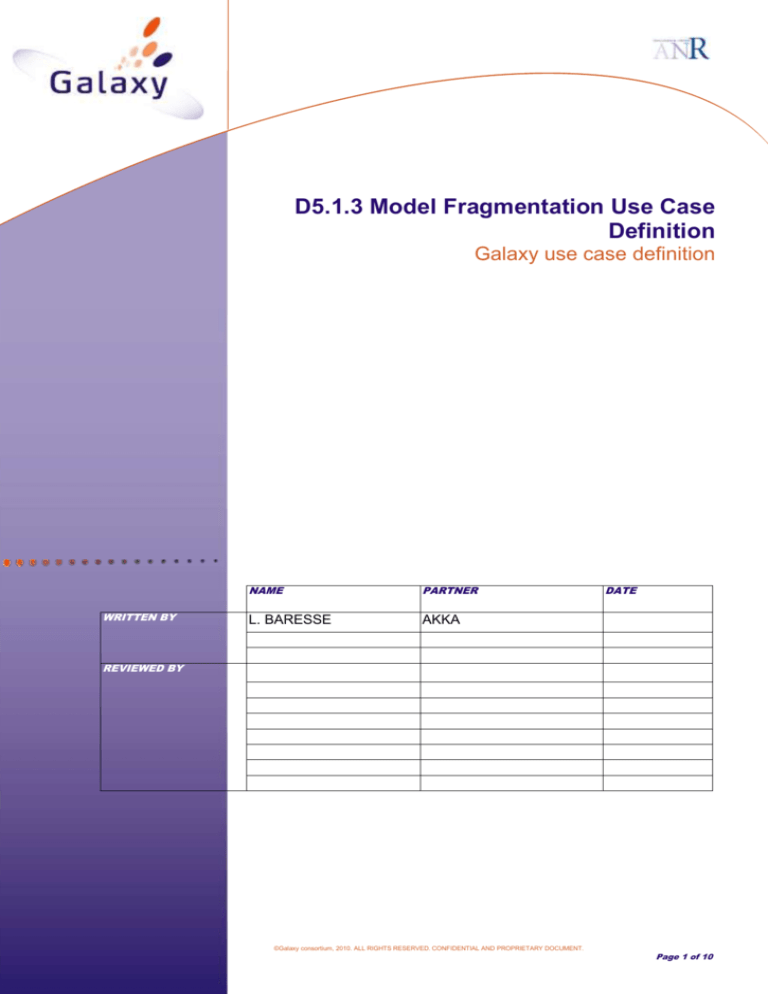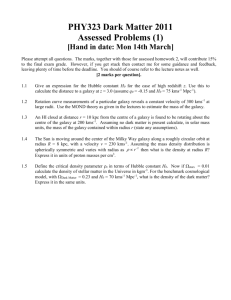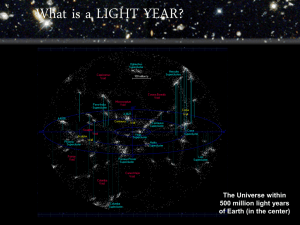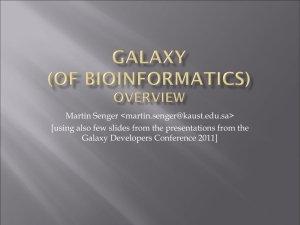
D5.1.3 Model Fragmentation Use Case
Definition
Galaxy use case definition
WRITTEN BY
NAME
PARTNER
L. BARESSE
AKKA
DATE
REVIEWED BY
©Galaxy consortium, 2010. ALL RIGHTS RESERVED. CONFIDENTIAL AND PROPRIETARY DOCUMENT.
Page 1 of 10
Model Fragmentation Use Case Definition
PROJECT: GALAXY
REFERENCE: D5.1.x
ISSUE:
1.0Draft1
Galaxy use cases definition
RECORD OF REVISIONS
ISSUE
DATE
EFFECT ON
PAGE
01A
ARPEGE 2009
DATE:
05/09/2011
REASONS FOR REVISION
PARA
Document creation
©Galaxy consortium, 2010. ALL RIGHTS RESERVED. CONFIDENTIAL AND PROPRIETARY DOCUMENT.
Page 2 of 10
Model Fragmentation Use Case Definition
Galaxy use cases definition
PROJECT: GALAXY
REFERENCE: D5.1.x
ISSUE:
1.0Draft1
ARPEGE 2009
DATE:
05/09/2011
TABLE OF CONTENTS
1. INTRODUCTION
5
1.1
GOAL OF THIS DOCUMENT
5
1.2
DOCUMENT ORGANIZATION
5
2. SCOPE
5
2.1
DESCRIPTION OF THE <XX> SYSTEM
5
2.2
SCOPE OF THE STUDY
6
3. VALIDATION METHOD
6
4. INVOLVED PARTNERS
7
5. VALIDATION SCENARIOS
7
6. INVOLVED MODELS
9
7. TOOLS USED
10
©Galaxy consortium, 2010. ALL RIGHTS RESERVED. CONFIDENTIAL AND PROPRIETARY DOCUMENT.
Page 3 of 10
Model Fragmentation Use Case Definition
PROJECT: GALAXY
REFERENCE: D5.1.x
ISSUE:
1.0Draft1
Galaxy use cases definition
TABLE OF APPLICABLE DOCUMENTS
N°
TITLE
REFERENCE
ISSUE
DATE
ARPEGE 2009
DATE:
05/09/2011
SOURCE
SIGLUM
NAME
A1
A2
A3
A4
TABLE OF REFERENCED DOCUMENTS
N°
TITLE
R1 Galaxy glossary
R2 Goal and metrics document
R3 Architecture specification
R4
REFERENCE
ISSUE
D1.2.2
D1.1
D4.1
ACRONYMS AND DEFINITIONS
Except if explicitly stated otherwise the definition of all terms and acronyms provided in [R1] is applicable in
this document. If any, additional and/or specific definitions applicable only in this document are listed in the
two tables below.
Acronymes
ACRONYM
DESCRIPTION
MF
MFC
Model Fragment
Model Fragment Client
Definitions
TERMS
DESCRIPTION
©Galaxy consortium, 2010. ALL RIGHTS RESERVED. CONFIDENTIAL AND PROPRIETARY DOCUMENT.
Page 4 of 10
Model Fragmentation Use Case Definition
Galaxy use cases definition
PROJECT: GALAXY
REFERENCE: D5.1.x
ISSUE:
1.0Draft1
ARPEGE 2009
DATE:
05/09/2011
1. INTRODUCTION
The goal of the Galaxy project is to work on the technical hard points related to the fragmentation
and to the distributiveness of huge models, and to their synchronization in regards of the
communication means classically used by development teams. Galaxy partners believe that a set
of technical solution integrated in a common platform of service (called: “the Galaxy platform”) may
greatly help in dealing with these hard points.
Based on a selected subset of candidate technologies, the architecture of the platform has been
specified. As planned in the project proposal this platform is assessed using use cases where
scalability issues can be identified and characterized.
1.1
GOAL OF THIS DOCUMENT
A specific task of the Galaxy project (T5.1) is dedicated to the definition of the use cases. This
document is a product of this task which describes the Model Fragmentation study case.
1.2
DOCUMENT ORGANIZATION
The chapter 2 describes the context of the test case, including an overview of the domain and a
focus on the scope on which of particular interest for the study.
Chapter 3 explains how the approach we have selected to verify and validate the added value of
the services provided by the Galaxy platform.
Chapter 4 presents the partners involved on this study case and the way they have contributed to
it.
Chapter 5 specifies the scenarios which are used to assess the performance offered by the Galaxy
platform.
Chapter 6 describes the models involved in validation scenarios are played: viewpoints, views,
sizes and organizations.
Last, Chapter 7 is about the tools software tools used for the validation scenarios.
2. SCOPE
2.1
DESCRIPTION OF THE MODEL FRAGMENTATION SYSTEM
Describe here the context of the domain of the study case and specific concepts of interest which
helps in getting a better understanding of it.
Model Fragments are an important part of the Galaxy platform. They represent model elements
that are a subset of a larger model. Any participant can create a Model Fragment and publish it to
the Galaxy repository. Another Participant can later fetch these Model Fragments into their model.
Model Fragments are versioned and have the particularity to be in a non mutable state once they
are deployed. So the elements of a first model, represented by a Model Fragment, can be
referenced in another one. Also, Model Fragments can have dependency between them, meaning
that importing a Model Fragment with such dependencies, all the Model Fragments it depends on
must have been imported as well.
©Galaxy consortium, 2010. ALL RIGHTS RESERVED. CONFIDENTIAL AND PROPRIETARY DOCUMENT.
Page 5 of 10
Model Fragmentation Use Case Definition
Galaxy use cases definition
PROJECT: GALAXY
REFERENCE: D5.1.x
ISSUE:
1.0Draft1
ARPEGE 2009
DATE:
05/09/2011
The Model Fragment technology is a mean to fragment huge models into a subset of smaller
models, with a robust versioning and inter fragment dependency system. This technology
emphasizes on encapsulation, which always is a good point when working on engineering projects.
A Model Fragment is a published archive of a subset of models. This subset should be lighter than
the original models (filter mechanism must be setup: e.g. only public model elements will be
included in the Model Fragment archive). A Model Fragment is tightly coupled to a set of model
elements which are managed by a logical team (not everybody can work on the model elements).
Should another team need to reference or to use model elements coming from this set of model
elements, this last team will have to get the published archive of the Model Fragment.
It means only a logical team will have access to the real set of model elements in read/write mode.
This logical team will have to publish versioned archives into the Galaxy repository in order to
collaborate with other teams.
This archive is published in a non mutable state (read only mode) on a Galaxy repository. This
archive will be then used by other users/entities without having access the real model elements
details.
2.2
SCOPE OF THE STUDY
Focus here on the perimeter directly involved in the study case. Describe the scalability issues
which are used to assess the added value of the platform
This use case will focus on the Model Fragment contribution for the Galaxy architecture. This
contribution mainly addresses scalability issues and is part of the core solution provided by Galaxy.
Model Fragment covers the following requirements as stated in the D.4.1 document:
GlxR_Coll_14: The system shall support bottom-up development approaches
GlxR_Intg_01: The system shall allow connecting heterogeneous tools to exchange models
or parts of model (i.e. building blocks) between them
GlxR_Intg_02: The system shall be connectable to the Softeam Modelio tool
GlxR_Intg_03: The system shall be connectable to the Eclipse MDT Papyrus tool
3. VALIDATION METHOD
Explain the approach and the process applied on this study case.
As previously stated there are two main scenarios. Both have to be validated and are loosely
coupled.
The first scenario is related to the Model Fragment edition and publication. It is the Model
Fragment producer point of view. During this scenario there is a dedicated team of Galaxy users
which work on the model elements which compose a Model Fragment. These users should be able
to work on their fully detailed model elements without constraint: read / write, commit / check out,
etc. Should their work could be published as a valid version of the models, thanks to the Galaxy
agent in their IDE, they will be able to create and publish a Model Fragment to do it.
The second scenario will focus on the Model Fragment consumer point of view. Thanks to Galaxy
agent in their IDE, users will be able to find and retrieve published Model Fragments for a specific
©Galaxy consortium, 2010. ALL RIGHTS RESERVED. CONFIDENTIAL AND PROPRIETARY DOCUMENT.
Page 6 of 10
Model Fragmentation Use Case Definition
Galaxy use cases definition
PROJECT: GALAXY
REFERENCE: D5.1.x
ISSUE:
1.0Draft1
ARPEGE 2009
DATE:
05/09/2011
version and all their dependencies (which are also versioned published Model Fragments and their
dependencies).
4. INVOLVED PARTNERS
All partner directly involved in this study case are listed here with their respective contribution.
The involved partners are Airbus, AKKA and Softeam.
5. VALIDATION SCENARIOS
Describe the validation scenarios here:
Involved service of the Galaxy platform
procedure,
assessed metrics and corresponding objectives
5.1
MODEL FRAGMENT EDITION & PUBLICATION
It is the Model Fragment producer point of view.
During this scenario there is a dedicated team of Galaxy users which work on the model elements
which compose a Model Fragment. These users should be able to work on their fully detailed
model elements without constraint: read / write, commit / check out, etc.
Should their work could be published as a valid version of the models, thanks to the Galaxy agent
in their IDE, they will be able to create and publish a Model Fragment to do it.
5.1.1 Initialize a Model Fragment definition
This scenario aims to assess:
Ability to set and update metadata for a Model Fragment definition.
Model Fragment Client (MFC) shall permit users to set and update metadata for a MF. These
metadata will be stored in the MF dependency file. Metadata are name, description and version.
5.1.2 Add/Remove/Modify model elements to/from a Model Fragment definition
This scenario aims to assess:
Ability to add model elements to a Model Fragment definition.
Ability to remove model elements from a Model Fragment definition.
Ability to update model elements in a Model Fragment definition.
Model Fragment definition shall contain the complete list of model elements which shall be
packaged and then published with the Model Fragment. MFC shall support users during this task
and at least raise error message should something impossible is required during this phase. For
instance, at least one model element depends of something which is not in the current MF and not
in another MF described in the dependency list.
©Galaxy consortium, 2010. ALL RIGHTS RESERVED. CONFIDENTIAL AND PROPRIETARY DOCUMENT.
Page 7 of 10
Model Fragmentation Use Case Definition
Galaxy use cases definition
PROJECT: GALAXY
REFERENCE: D5.1.x
ISSUE:
1.0Draft1
ARPEGE 2009
DATE:
05/09/2011
5.1.3 Add/Remove/Modify dependency to/from a Model Fragment definition
This scenario aims to assess:
Ability to add a Model Fragment dependency to a Model Fragment definition.
Ability to remove a Model Fragment dependency from a Model Fragment definition.
Ability to update a Model Fragment dependency in a Model Fragment definition.
Model Fragment Client (MFC) shall permit users to set and update dependencies information for a
MF. These metadata will be stored in the MF dependency file. A dependency is defined by the MF
(qualified) name and its version. This couple shall be unique in the Galaxy Repository.
Note: Transitive dependencies shall be handled by the Galaxy architecture. As a consequence, if A
depends of B and B depends of C; a project (or a MF) P which declare a dependency on A will
automatically depends of B and C. It’s not required for P to declare explicit dependencies to B and
C.
5.1.4 Add/Remove/Modify file to/from a Model Fragment definition
This scenario aims to assess:
Ability to add a file to a Model Fragment definition.
Ability to remove a file from a Model Fragment definition.
Ability to update a file in a Model Fragment definition.
Model Fragment Client (MFC) shall permit users to add, remove and update files which will be
packaged with the MF. These files are not managed by the Galaxy architecture, it’s only a
convenient way to share unverified files related to the MF it-self such as PNG files to exchange
diagrams, but also generated source code files, etc.
5.1.5 Create and package a Model Fragment from its definition
This scenario aims to assess:
Ability to create and package a Model Fragment according to its definition.
Model Fragment Client (MFC) shall permit users to create and package a MF according to its
previously established definition. During this phase the model elements should be simplify in order
to not publish irrelevant information (e.g. only public model elements should be exported during the
MF creation process).
A Model Fragment shall be packaged in a ZIP file format to facilitate its exchange and storage on
the Galaxy Repository via the Galaxy Server. The ZIP file shall contain the exported model
elements, the list of files described in the MF definition and a dependency file which must contain
all dependencies declarations and metadata information.
5.1.6 Publish a Model Fragment on the Galaxy Repository
This scenario aims to assess:
©Galaxy consortium, 2010. ALL RIGHTS RESERVED. CONFIDENTIAL AND PROPRIETARY DOCUMENT.
Page 8 of 10
Model Fragmentation Use Case Definition
Galaxy use cases definition
PROJECT: GALAXY
REFERENCE: D5.1.x
ISSUE:
1.0Draft1
ARPEGE 2009
DATE:
05/09/2011
Ability to publish a Model Fragment archive on the Galaxy Repository via the Galaxy
Server.
Model Fragment Client (MFC) shall permit users to publish on the Galaxy Repository via the
Galaxy Server a packaged MF. The packaged MF file shall contain the exported model elements,
the list of files described in the MF definition and a dependency file which must contain all
dependencies declarations and metadata information.
Should a MF with the same qualified name and version already published on the Galaxy
Repository, the Galaxy server shall return an error to the MFC. Published MF are non mutable. It
shall be impossible to update / delete them from the Galaxy Repository. The reason is since a MF
is published on the Galaxy Repository, it becomes public. Anyone can retrieve and use a public
MF published on the Galaxy Repository. It’s therefore a non-sense to think about updating or
deleting something that someone could have been retrieved. Should anything required to be
modified in a MF (e.g. the Model Fragment Foo version 1.0 published on the Galaxy Repository is
inconsistent), a new version of this MF shall be published on the Galaxy Repository.
5.2
MODEL FRAGMENT FIND & RETRIEVE
5.2.1 Find a published Model Fragment from the Galaxy Repository
This scenario aims to assess:
Ability to find a published Model Fragment from the Galaxy Repository.
Model Fragment Client (MFC) shall permit users to find a published Model Fragment from the
Galaxy Repository. MFC shall be able to retrieve all the published MF in all available versions, or
all with a matching name or the MF with a matching name and an available matching version.
5.2.2 Retrieve from the Galaxy Repository a published Model Fragment for a given
version
This scenario aims to assess:
Ability to retrieve form the Galaxy Repository a published Model Fragment for a given
version and all its dependencies.
Model Fragment Client (MFC) shall permit users to retrieve form the Galaxy Repository a
published Model Fragment for a given version. Should the MF have dependencies, these MFs
shall also be retrieved within the same operation (transitive dependencies mechanism shall be
implemented here).
6. INVOLVED MODELS
List and describe the kind of models (view, viewpoint) involved in the study case and the way they
are organized (relationships)
©Galaxy consortium, 2010. ALL RIGHTS RESERVED. CONFIDENTIAL AND PROPRIETARY DOCUMENT.
Page 9 of 10
Model Fragmentation Use Case Definition
Galaxy use cases definition
PROJECT: GALAXY
REFERENCE: D5.1.x
ISSUE:
1.0Draft1
ARPEGE 2009
DATE:
05/09/2011
To be completed
7. TOOLS USED
List the tools used in this study case with their corresponding version and purpose.
The Model Fragment infrastructure shall be available since the 1st validation phase, the following
tools will be used:
Galaxy Server
o Model Fragment Engine
Galaxy Repository
Topcased/Papyrus based MDE Tool
o Galaxy Agent
Model Fragment Client
Modelio based MDE Tool
o Galaxy Agent
Model Fragment Client
©Galaxy consortium, 2010. ALL RIGHTS RESERVED. CONFIDENTIAL AND PROPRIETARY DOCUMENT.
Page 10 of 10









